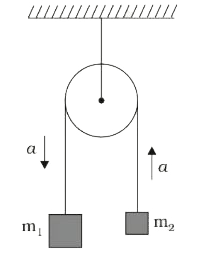A stationary body explodes into two fragments of masses m1 and m2. If momentum of one fragment is p, the energy of explosion is
p22(m1+m2)
p22√m1m2
p2(m1+m2)2m1m2
p22(m1−m2)
The correct Answer is:C
To solve the problem, we will follow these steps:
Step 1: Understand the conservation of momentum
Since the body is initially stationary, its initial momentum is zero. According to the law of conservation of momentum, the total momentum after the explosion must also be zero. Therefore, if one fragment has momentum p, the second fragment must have momentum −p to ensure the total momentum remains zero.
Step 2: Define the momenta of the fragments
Let:
- m1 be the mass of the first fragment.
- m2 be the mass of the second fragment.
- The momentum of the first fragment is p.
- The momentum of the second fragment is −p.
From the momentum definition, we have:
- For the first fragment: p=m1v1 (where v1 is the velocity of the first fragment).
- For the second fragment: −p=m2v2 (where v2 is the velocity of the second fragment).
Step 3: Relate velocities to momenta
From the equations above, we can express the velocities in terms of the momenta:
- v1=pm1
- v2=−pm2
Step 4: Calculate the kinetic energies of the fragments
The kinetic energy (KE) of each fragment can be calculated using the formula KE=12mv2.
For the first fragment:
KE1=12m1v21=12m1(pm1)2=p22m1
For the second fragment:
KE2=12m2v22=12m2(−pm2)2=12m2(p2m22)=p22m2
Step 5: Calculate the total energy of the explosion
The total energy of the explosion is the sum of the kinetic energies of both fragments:
E=KE1+KE2=p22m1+p22m2
Factoring out p22:
E=p22(1m1+1m2)
Final Result
Thus, the energy of the explosion is:
E=p22(1m1+1m2)
Since the body is initially stationary, its initial momentum is zero. According to the law of conservation of momentum, the total momentum after the explosion must also be zero. Therefore, if one fragment has momentum p, the second fragment must have momentum −p to ensure the total momentum remains zero.
Let:
- m1 be the mass of the first fragment.
- m2 be the mass of the second fragment.
- The momentum of the first fragment is p.
- The momentum of the second fragment is −p.
- For the first fragment: p=m1v1 (where v1 is the velocity of the first fragment).
- For the second fragment: −p=m2v2 (where v2 is the velocity of the second fragment).
From the equations above, we can express the velocities in terms of the momenta:
- v1=pm1
- v2=−pm2
The kinetic energy (KE) of each fragment can be calculated using the formula KE=12mv2.
KE1=12m1v21=12m1(pm1)2=p22m1
KE2=12m2v22=12m2(−pm2)2=12m2(p2m22)=p22m2
The total energy of the explosion is the sum of the kinetic energies of both fragments:
E=KE1+KE2=p22m1+p22m2
Factoring out p22:
E=p22(1m1+1m2)
Thus, the energy of the explosion is:
E=p22(1m1+1m2)
Topper's Solved these Questions
- CENTRE OF MASSBOOK - CENGAGE PHYSICS ENGLISHCHAPTER - CENTRE OF MASSEXERCISE - Multiple Correct
25 Videos
- CENTRE OF MASSBOOK - CENGAGE PHYSICS ENGLISHCHAPTER - CENTRE OF MASSEXERCISE - Assertion - Reasoning
2 Videos
- CENTRE OF MASSBOOK - CENGAGE PHYSICS ENGLISHCHAPTER - CENTRE OF MASSEXERCISE - Subjective
23 Videos
- CALORIMETRYBOOK - CENGAGE PHYSICS ENGLISHCHAPTER - CALORIMETRYEXERCISE - Solved Example
13 Videos
- DIMENSIONS & MEASUREMENTBOOK - CENGAGE PHYSICS ENGLISHCHAPTER - DIMENSIONS & MEASUREMENTEXERCISE - Integer
2 Videos
Similar Questions
Two bodies of masses m1andm2(<m1) are connected to the ends of a massless cord and allowed to move as shown in figure. The pulley is both massless and frictionless. The acceleration of the centre of mass is (m1−m2)n(m1+m2)2g. Find the value of n.

View SolutionA shell at rest on a smootyh horizontal surface explodes into two fragments of masses m1 and m2. If just after explosion, m1 move with speed u, then work done by internal forces during explosion is :-
View Solution
Knowledge Check
An object of mass 5 kg is projecte with a velocity of 20ms−1 at an angle of 60∘ to the horizontal. At the highest point of its path , the projectile explodes and breaks up into two fragments of masses 1kg and 4 kg. The fragments separate horizontally after the explosion, which releases internal energy such that K.E. of the system at the highest point is doubled. Calculate the separation betweent the two fragments when they reach the ground.
A11 mB22 mC44 mD66 m
A bomb at rest explodes into two parts of masses m1 and m2. If the momentums of the two parts be P1 and P2, then their kinetic energies will be in the ratio of:
View SolutionConsider a body at rest in the L-Frame, which explodes into fragments of masses m1 and m2. Calculate energies of the fragments of the body.

View SolutionA stationary shell explodes into two fragments, having masses in the ratio of 1:2. The heavier fragment attains a Kinetic energy of 100J. The Kinetic energy released in the explosion is:
View SolutionA stationary particle explodes into two particle of a masses m1andm2 which move in opposite direction with velocities v1andv2. The ratio of their kinetic energies E1/E2 is
View SolutionA bomb of mass m is projected from the ground with speed v at angle θ with the horizontal. At the maximum height from the ground it explodes into two fragments of equal mass. If one fragment comes to rest immediately after explosion, then the horizontal range of centre of mass is
View SolutionA projectile is fired with velocity.v0 at an angle 60∘ with horizontal . At top of its trajectory it explodes into two fragments of equal mass. If one fragment retraces the path then the speed of the other fragment is
View SolutionAn isolated particle of mass m is moving in horizontal planexy along the x-axis, at a certain height above the ground. It suddenly explodes into two fragment of masses m/4 and 3m/4. An instant later, the smaller fragment is at y=+15 cm. The larger fragment at this instant is at
View Solution
